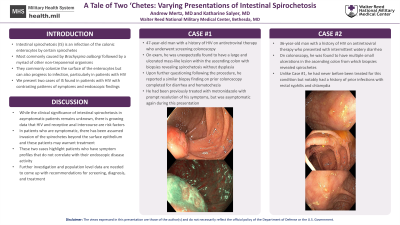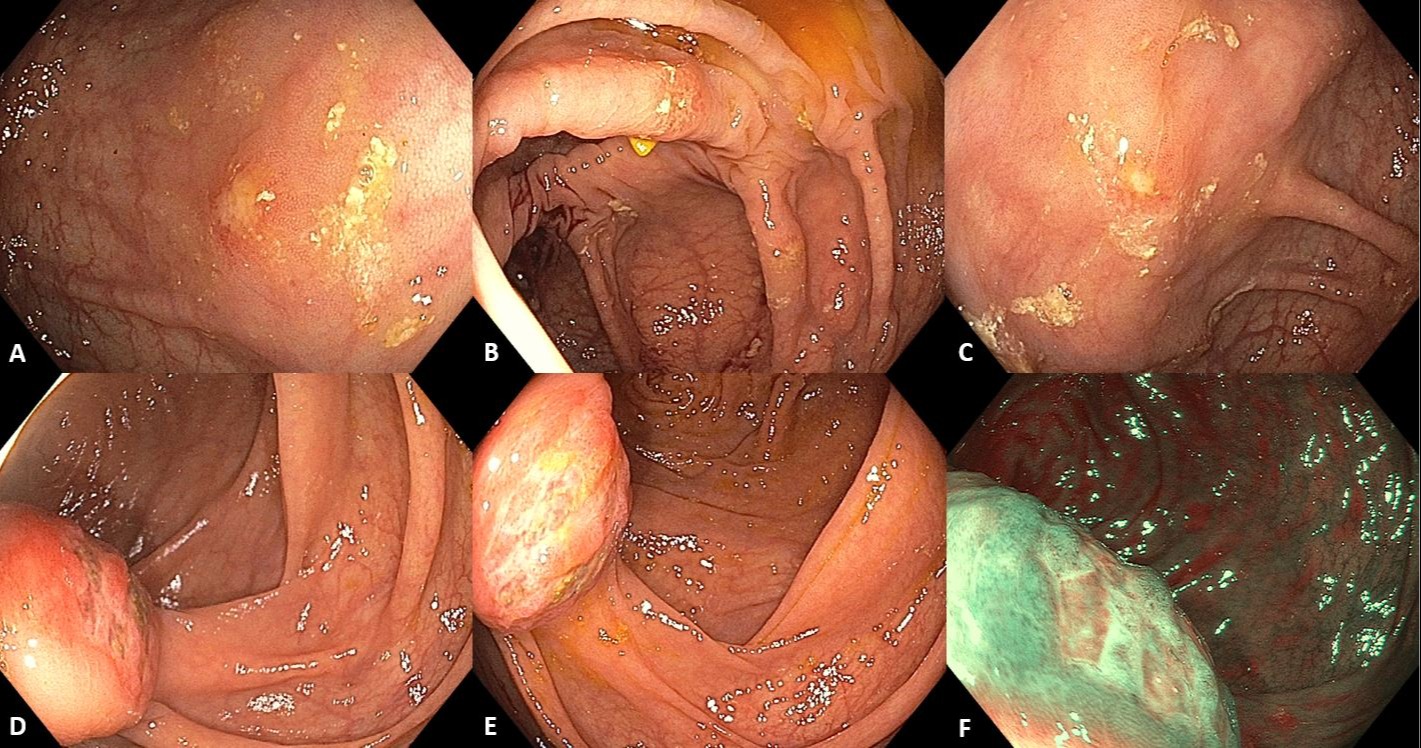Sunday Poster Session
Category: Colon
P0237 - A Tale of Two 'Chetes: Varying Presentations of Intestinal Spirochetosis
Sunday, October 22, 2023
3:30 PM - 7:00 PM PT
Location: Exhibit Hall

Has Audio

Andrew Mertz, MD
Walter Reed National Military Medical Center
Bethesda, MD
Presenting Author(s)
Andrew Mertz, MD, Katharine Salyer, MD
Walter Reed National Military Medical Center, Bethesda, MD
Introduction: Intestinal spirochetosis (IS) is an infection of the colonic enterocytes by certain species of spirochetes. The most common causative organism is Brachyspira aalborgi followed by a myriad of other non-treponemal spirochetes. These organisms can commonly colonize the surface of the enterocytes but can also progress to infection, particularly in patients with Human Immunodeficiency Virus (HIV). Herein, we present two cases of IS found in patients with HIV with contrasting patterns of symptoms and endoscopic findings.
Case Description/Methods: Our first patient is a 47-year-old man with a history of HIV on retroviral therapy who underwent screening colonoscopy. On exam, he was unexpectedly found to have a large and ulcerated mass-like lesion within the ascending colon with biopsies revealing spirochetosis without dysplasia. Interestingly, upon further questioning following the procedure, he reported a similar biopsy finding on prior colonoscopy completed for diarrhea and hematochezia. He had been previously treated with metronidazole with prompt resolution of his symptoms, but again was asymptomatic during this presentation.
Our second patient is a 36-year-old man with a history of HIV on retroviral therapy who presented with intermittent watery diarrhea. On colonoscopy, he was found to have multiple small ulcerations in the ascending colon from which biopsies revealed spirochetes. Unlike our first patient, he had never before been treated for this condition but notably had a history of prior infections with rectal syphilis and chlamydia.
Notably, both above patients were participating in receptive anal intercourse and had been treated for sexually transmitted infections in the past. In addition, with regard to HIV status, each had a viral load that was non-detectable and a CD4 count greater than 250 cells/mL.
Discussion: While the clinical significance of intestinal spirochetosis in asymptomatic patients remains unknown, there is growing data that HIV and receptive anal intercourse are risk factors. In patients who are symptomatic, there has been assumed invasion of the spirochetes beyond the surface epithelium and these patients may warrant treatment. Interestingly, these two cases highlight patients who seemingly have symptom profiles that do not correlate with their endoscopic disease activity. Further investigation and population level data are needed to come up with any concrete recommendations for screening, diagnosis, and treatment.

Disclosures:
Andrew Mertz, MD, Katharine Salyer, MD. P0237 - A Tale of Two 'Chetes: Varying Presentations of Intestinal Spirochetosis, ACG 2023 Annual Scientific Meeting Abstracts. Vancouver, BC, Canada: American College of Gastroenterology.
Walter Reed National Military Medical Center, Bethesda, MD
Introduction: Intestinal spirochetosis (IS) is an infection of the colonic enterocytes by certain species of spirochetes. The most common causative organism is Brachyspira aalborgi followed by a myriad of other non-treponemal spirochetes. These organisms can commonly colonize the surface of the enterocytes but can also progress to infection, particularly in patients with Human Immunodeficiency Virus (HIV). Herein, we present two cases of IS found in patients with HIV with contrasting patterns of symptoms and endoscopic findings.
Case Description/Methods: Our first patient is a 47-year-old man with a history of HIV on retroviral therapy who underwent screening colonoscopy. On exam, he was unexpectedly found to have a large and ulcerated mass-like lesion within the ascending colon with biopsies revealing spirochetosis without dysplasia. Interestingly, upon further questioning following the procedure, he reported a similar biopsy finding on prior colonoscopy completed for diarrhea and hematochezia. He had been previously treated with metronidazole with prompt resolution of his symptoms, but again was asymptomatic during this presentation.
Our second patient is a 36-year-old man with a history of HIV on retroviral therapy who presented with intermittent watery diarrhea. On colonoscopy, he was found to have multiple small ulcerations in the ascending colon from which biopsies revealed spirochetes. Unlike our first patient, he had never before been treated for this condition but notably had a history of prior infections with rectal syphilis and chlamydia.
Notably, both above patients were participating in receptive anal intercourse and had been treated for sexually transmitted infections in the past. In addition, with regard to HIV status, each had a viral load that was non-detectable and a CD4 count greater than 250 cells/mL.
Discussion: While the clinical significance of intestinal spirochetosis in asymptomatic patients remains unknown, there is growing data that HIV and receptive anal intercourse are risk factors. In patients who are symptomatic, there has been assumed invasion of the spirochetes beyond the surface epithelium and these patients may warrant treatment. Interestingly, these two cases highlight patients who seemingly have symptom profiles that do not correlate with their endoscopic disease activity. Further investigation and population level data are needed to come up with any concrete recommendations for screening, diagnosis, and treatment.

Figure: A, B, C - Endoscopic imagings of cecum and ascending colon in patient #1 who presented with diarrhea and hematochezia.
D, E, F - Endoscopic images of ascending colon mass-like lesion in patient #2 who presented without symptoms for routine screening colonoscopy.
D, E, F - Endoscopic images of ascending colon mass-like lesion in patient #2 who presented without symptoms for routine screening colonoscopy.
Disclosures:
Andrew Mertz indicated no relevant financial relationships.
Katharine Salyer indicated no relevant financial relationships.
Andrew Mertz, MD, Katharine Salyer, MD. P0237 - A Tale of Two 'Chetes: Varying Presentations of Intestinal Spirochetosis, ACG 2023 Annual Scientific Meeting Abstracts. Vancouver, BC, Canada: American College of Gastroenterology.
